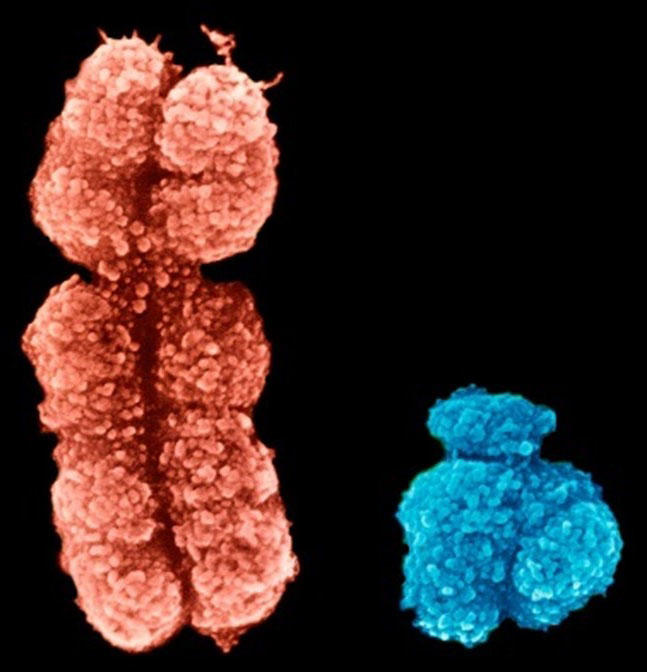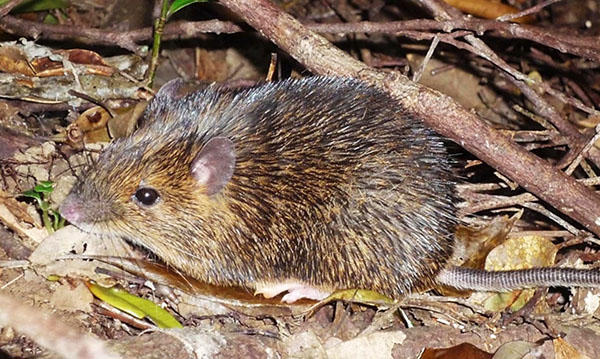How does the Y chromosome work and is it declining? In this Academic Blog, Dr Chris Brown, Principal Lecturer in Zoology/Biology in the School of Science and the Environment, examines how sex is determined and if the Y chromosome is reducing in size.
Most plants and animals have a mechanism that determines whether an individual will be male or female; this sex-determination system dictates the development of different gender characteristics. In mammals, sex is determined genetically by chromosomal differences: females have two X sex chromosomes and males have one X and one Y sex chromosome. It is the presence or absence of a Y chromosome in the sperm cell that determines the sex of any offspring.
So, what is it about the Y chromosome that determines a male offspring?
 Human X chromosome (orange) and Y chromosome (blue) (ndla.zendesk.com BY-NC 4.0 DEED)
Human X chromosome (orange) and Y chromosome (blue) (ndla.zendesk.com BY-NC 4.0 DEED)
In humans, before about six weeks of embryonic development, the embryonic gonads have the potential to become either testes or ovaries and hence the child could become either a boy or a girl. At this stage the embryo also contains precursors of the rest of both male and female reproductive anatomy.
Male development is triggered by a protein, which is expressed by a gene, the Sry gene, located on the short arm of the Y chromosome. This protein instructs another gene, called Sox9 to get to work. When Sox9 is ‘turned on’, it causes the embryo’s undifferentiated gonads to develop into testes. The developing testes begin to produce testosterone, which induces the development of the other male reproductive organs. Cells of the developing testes also produce a second hormone, Anti-Müllerian hormone, that causes the degeneration of the precursor female reproductive anatomy. In the absence of the Y chromosome, however, there is no Sry gene, no activation of Sox9, no testis development, no testosterone and no anti-Müllerian hormone and sex development proceeds down the female pathway by default. Without the Sry gene on the Y chromosome, the developing baby will be a girl.
The Y chromosome is consequently vital for the development of males…. or is it?
Looking at a photograph of the X and Y chromosomes, the Y chromosome is rather insignificant looking compared to the X chromosome. Current thinking is that sex chromosomes in mammals evolved about 180 million years ago, during the mid-Jurassic period, from two non-sex chromosomes. One of these chromosomes subsequently gained a sex-determining role through mutation of one or more genes and became the Y chromosome and the other the X chromosome. The mammalian Y chromosome, including that of humans, has been reducing in size ever since and, over time, has lost almost 97% of its original gene complement! In contrast, the X chromosome has remained relatively intact. The human Y chromosome now carries only about 50 genes compared to about 1,400 on the X-chromosome. Some researchers have estimated that, at the current rate of degeneration, the human Y chromosome could be lost altogether in the next 5 - 10 million years!
Does this mean the demise of males? Not necessarily. There are several species of insects, including some grasshoppers, crickets and cockroaches that lack a Y chromosome. The presence of two X chromosomes results in females whereas the lack of a second X chromosome leads to male development.
 Amami spiny rat rat (Tokudaia osimensis)
Amami spiny rat rat (Tokudaia osimensis)
But what might happen with the loss of the Y chromosome in humans? Some mammals like the Amami spiny rat and the Tokunoshima spiny rat, along with two species of mole voles, already lack a Y chromosome, and hence the Sry gene. Given that there are still male spiny rats running around without a Y chromosome, they must have evolved a new sex-determining mechanism independent of the Sry gene. Some researchers have suggested that a new sex-determining gene has developed somewhere else in their DNA. Others have suggested that the male-determining gene has moved from the Y chromosome to another chromosome. Extensive research, however, has failed to identify an alternative sex-determining candidate gene.
In a study published in 2023, a team of researchers led by Professor Asato Kuroiwa at Hokkaido University have now shed some light on the conundrum. In Amami spiny rats, the researchers found a short, duplicated DNA sequence that was present only in the males. This duplicated region was located on chromosome 3. This gene sequence activated Sox9 in the absence of the Sry gene. This suggests that the sex-determining mechanism in the Amami spiny rat has moved to chromosome 3, a non-sex chromosome. This is the first example of a translocation of a sex-determining mechanism in mammals. The gene that can activate Sox9 in the absence of Sry, has become the new sex determining factor in the spiny rat.
This finding suggests that there is hope for males after all and that they will not necessarily disappear with the eventual demise of the Y chromosome but that an alternative male-determining factor will evolve. Not that females actually need males to reproduce. Females of an increasing number of species are being found that can produce viable offspring without fertilisation by males – a process called parthenogenesis. But that’s a story for another day.
Find out more about the School of Science and the Environment.